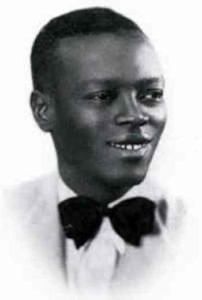
Heitor de
*On this date, in 1898, Heitor dos Prazeres was born. He was an Afro Brazilian composer, singer, and painter.
Heitor dos Prazeres was born in Rio de Janeiro to Eduardo Alexandre dos Prazeres, woodworker and clarinetist in the National Guard band, and the seamstress Celestina Gonçalves Martins, living in the Cidade Nova neighborhood. He was known as Lino and had two older sisters, Acirema and Iraci. His father taught him to play the clarinet in various rhythms like polkas, waltzes, choros, and marches, dying when he was seven.
Dos Prazeres dropped out of school in the fourth grade and learned carpentry. His uncle, a "Lalu de Ouro" musician, gave him his first cavaquinho. Following his uncle's steps, he learned the instrument and presented himself as Mano Heitor do Cavaquinho. He started playing in candomblé religious gatherings in houses where other experienced musicians played and improvised African rhythms such as jongo, lundu, cateretê, samba, etc. Some of the most important gatherings he attended were at the houses of vovó Celi, Tia Esther, Oswaldo Cruz, and tia Ciata, where musicians like Lalu de Ouro, Caninha, João da Baiana, Sinhô, Getúlio Marinho, Donga, Saturnino Gonçalves ("Satur"), Pixinguinha, and Paulo da Portela played.
While working as a shoeshine and newsboy, he frequented nearby breweries and silent movies near Praça Onze and Lapa cafes, where he could hear the typical Belle Époque musicians and orchestras in Rio de Janeiro. At thirteen, Heitor was imprisoned for truancy and spent two months in the Correctional Colony Dois Rios on Ilha Grande. While there, he wrote O limoeiro, Limão e Adeus, óculo, his first compositions, dated around 1912. In the 1920s, assisted by other sambistas and composers such as João da Baiana, Caninha, Ismael Silva, Alcebíades Barcelos ("Bide"), and Marçal he helped to organize various samba groups from Rio Comprido, Estácio and other places nearby, so was known as Mano Heitor of Estacio.
He attended meetings at Mangueira and Oswaldo Cruz with Cartola, Paulo da Portela, and others, which led to the creation of the first of several samba schools. Portela, in 1929 was the first winner of a school competition, with its composition Não Adianta Chorar. Two of his most popular songs were Deixaste meu lar and Estas farto de minha vida, both from 1925. Another song of his own from the same era was Deixe a malandragem se és capaz. In 1927, he won a samba contest with the song A Tristeza Me Persegue. In 1931 he married Dona Gloria, with whom he had three daughters, Ivete, Iriete, and Ionete Maria. After the death of his wife in 1936, he devoted himself to the visual arts, especially painting, at the encouragement of draftsman, journalist, and art critic Carlos Cavalcante, painter Augusto Rodrigues and writer Carlos Drummond de Andrade.
He also made percussion instruments and designed and made the costumes, furniture, and tapestry of his musical and dance groups. His home in Praça Tiradentes was a meeting point for people interested in his knowledge of Afro-Brazilian culture and its most important meeting centers. Among the visitors were the medical student and future composer Noel Rosa. Drummond, another of his frequent visitors, brought him a poem of his own to be set to music, O Homem e seu Carnaval (1934). Although it, he was later inspired by this poem to create a painting of the same name. In 1937, he exhibited paintings depicting life in the favelas: children playing, men playing or drinking, young people dancing the samba, etc. It represented the faces of people in profile, their heads and eyes turned upwards. At the request of his friend Carlos Cavalcante, in 1951, he participated in the first Biennial of Modern Art of São Paulo, winning the third prize at the national artist's exhibition with his painting Moenda. At the second São Paulo Biennial in 1953, a room was reserved for the exhibition of his work. He created sets and costumes for the ballet commemorating the fourth centenary of the city of São Paulo in 1954. In 1959, he exhibited individually at Rio de Janeiro's Galeria Gea for the first time. In 1965 Antonio Carlos da Fontoura directed a documentary about his life and work.
Heitor Dos Prazeres, a pioneer samba composer, participated in Brazil's first samba schools. Later in life, he became known for his paintings and died on October 4, 1966, in Rio de Janeiro, at 68 years old. He left a catalog of around 300 composed songs. In 1999, on the centenary of his birth, a retrospective of his pictorial work was held at Espaço BNDES and at the National Museum of Fine Arts of Rio de Janeiro. In 2003, journalist Alba Lírio published the book Heitor dos Prazeres: Sua Arte e Seu Tempo.